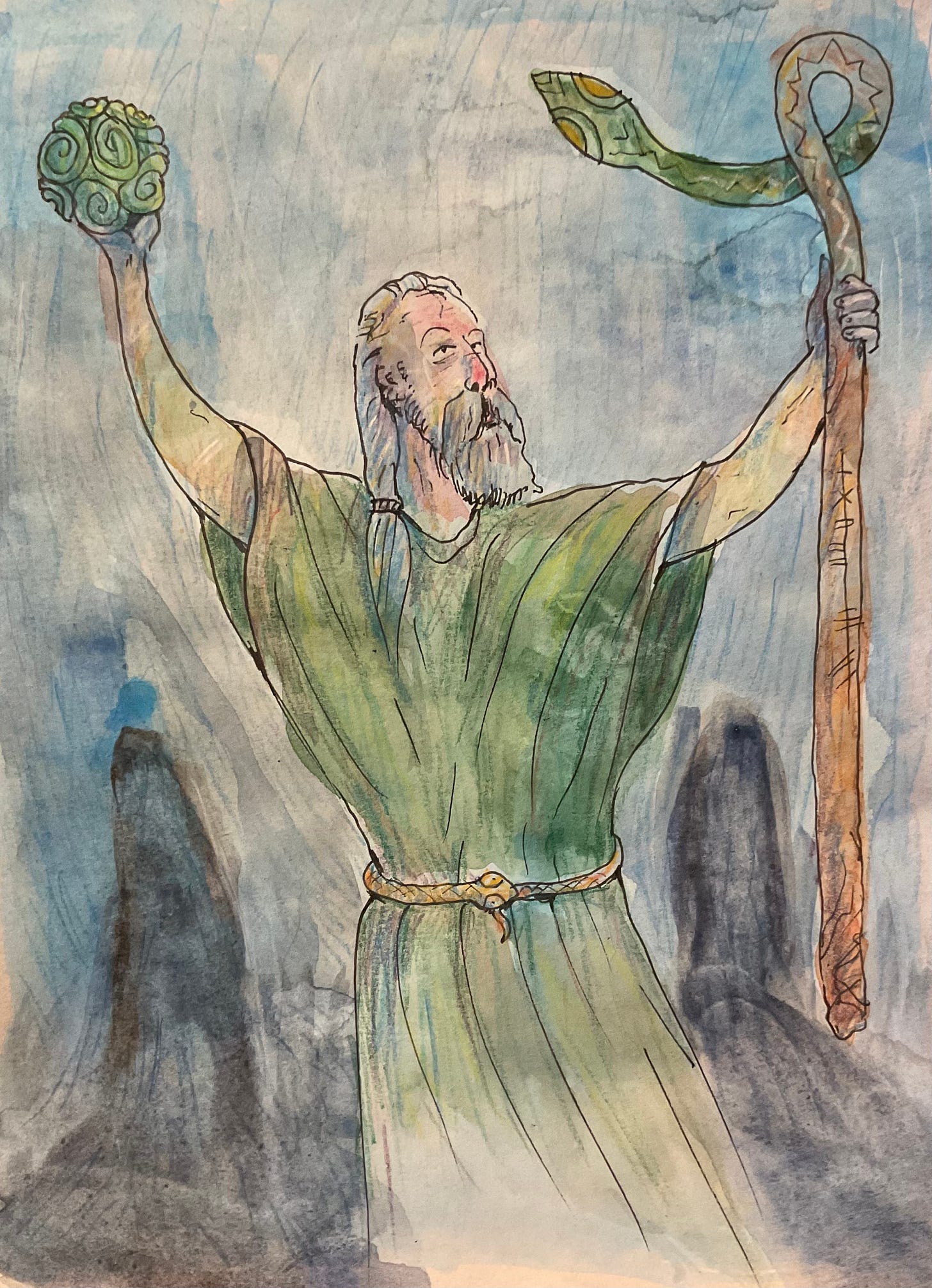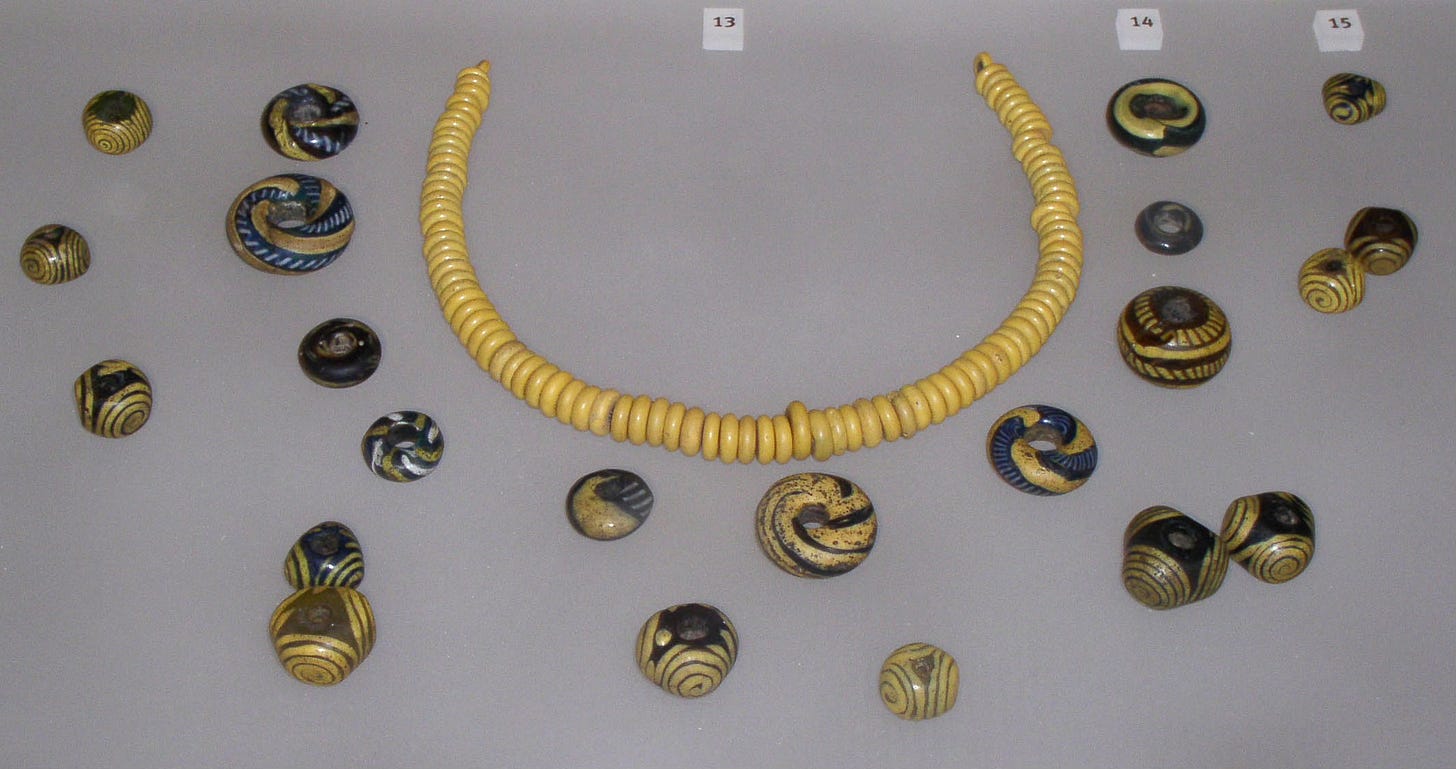Legend has it that Druids wore a sacred charm, known as the Druid’s egg. Sometimes they’re called adderstanes, or snake eggs but no one can quite agree on what they are and accounts vary. Some people say adder stones are any stone with a natural hole in the middle, what many call Hag-stones. Searching books of Scottish folklore from the 1800s reveals descriptions of objects that are actually glass – possibly ancient glass beads, taken from Tumuli by antiquarians before the era of proper archaeology*. J. Campbell writes that his was blue and white and glassy, which sounds very like accounts of the Welsh, Glain Neidr (Gelin Nedir).
Another account from the 1800s, given by a woman from Sutherland, explains that the ring is like ivory and formed by a white adder, from the slime of its body. Pliny names this substance as anguinum. This, he tells us, is formed by serpent mucus and a secretion issuing from between their scales. The stones are formed by groups of serpents, entwined in a ball, as rings of anguinum form around their bodies, and they eject them into the air with a hiss. At this point the waiting Druid must snatch the ring in his cloak, before it touches the ground, for that appears to break its power. He must then leap onto his horse and make for the nearest stream, lest the angry serpents claim him before he crosses moving water. Pliny even suggests a test for the effectiveness of the object, for the eggs should float against the current of a stream, even if they’ve been set in gold!
“I myself, however, have seen one of these eggs: it was round, and about as large as an apple of moderate size; the shell of it was formed of a cartilaginous substance, and it was surrounded with numerous cupules, as it were, resembling those upon the arms of the polypus: it is held in high estimation among the Druids.”
Here Pliny seems to suggest that it’s not a ring after all, in fact he’s describing something else. I must admit seeing pictures of fossilised sea urchins does make me wonder if the object in question was something like this. If you weren’t aware of how fossils are created, then to discover something so patterned would seem wondrous. They don’t look like they were created by nature. It had to be otherworldly, and therefore supernatural. But what we have, it seems, is the same idea hinged on different objects – from Hag Stones, to possible fossils.
Adders do bask in the sun in groups from time to time, and when mating the male and female coil about each other. Such a sight might insight awe, but it still feels like Pliny’s tale is a tall one.
I don't mean to denigrate the idea of the magic inherent in an adder stone or druid egg by suggesting they’re merely a natural phenomenon. But would that make them any less magical? If you didn't know the object’s origins, or how it was created, and if you believed it was magical then, surely, it was. For example, say you found a colourful wee stone in the woods, and for some reason something good happened that day, you might keep that stone with you, because you believe it's a lucky token. In a way it's a trigger, like the druid egg or adder Stone. We invest our belief into the object, when we hold it we trigger this belief. Many original magical formulae have very specific ingredients and directions. The person wishing to make a talisman or charm must undergo the necessary requirements, obtain the elusive materials, bury them under the full moon or at a certain time – undertaking a long process, that leads them away from the mundane, bonding with the charm and reinforcing their will. This, to my mind, is a kind of magic, the direct effects of which are deeply psychological.
Pliny even states that he knew of a Romanised Celt of the Vocontii**, who was slain by Emperor Tiberius for wearing a Druid egg during a trial. Tiberius violently suppressed the Gallic Druids during his reign. However the Druid eggs had a reputation for ensuring success in lawsuits… could the strength of belief attached to the object have been that powerful that a Roman emperor feared its presence?
And what if there’s more behind the myth? Snakes and serpents are intrinsic to ancient belief. Whether Celtic, Viking or ancient Grecian – there you'll find serpents, and you'll find dragons. An ancient belief tells of the cosmic egg; born by the union of Earth (Gaia) and Water (Hydros) were bound by the serpent of Time (Kronos), which enabled the egg to hatch and unleashed the constituent elements of creation. The myth varies, and is described in much length in the Orphic mystery texts. Could the Druids have possessed similar myths? It’s not impossible given the common roots of the Indo-Europeans. In fact, over the years, I’ve found mythical elements that are consistent: The Dragon Slaying myth, for example, is traceable in legends from from Mesopotamia to the Celtic climes.
The Orphic mysteries and Pythagorean philosophy shared much in common, as did the beliefs of the Druids – who believed in the rebirth of souls and were also heavily into geometry. There are links between the Pythagoreans and Druidry, with Roman sources saying the Druids even practiced Pythagorean ideas. Another source tells of Abaris, a Druid from the Hyperborean lands (ie; the Celts) who met with Pythagoras. The sources disagree whether the Druid taught Pythagoras or vice versa. But surely when such meetings took place knowledge flowed both ways, between Greek and Celt.
Looking at the descriptions in the light of metaphor, the ring and serpent brings to mind the Ouroboros. That enduring symbol of the cycle of life, and the unity of matter – a symbol known to the Egyptians and the gnostics. In this form the serpent appears a ring, with its tail clasped in its mouth.
In Celtic imagery the serpent features a lot. Surprisingly this overtly pagan image makes an appearance on a lot of early Christian imagery of the Celtic Christian period***. The high crosses of Iona, such as St. John’s Cross, or adorning the front of the Pictish stone of Nigg, display images of multiple serpents swirling around circular bosses. On the Nigg stone these bosses protrude from the surface and are intricately carved with knot work and spirals. Although contained within the context of Christian imagery, it’s tempting to speculate that these images reflect some other esoteric thought. We know that Christianity borrowed heavily from Greek philosophy, especially Neoplatonism. Why not others? Could those Druids who’d changed faiths have shared some influence in these designs?
These serpent bosses, with their geometric precision, remind me of the curious stone balls that are found throughout Scotland and known as petrospheres. These mysterious objects are dated to the late Neolithic, making them at least 5200 years old. They are carved from various types of stone, though greenstone seems to have been a preferred medium. Most often round, they are carved with carefully placed nodules. The most stunning example is the Towie Ball, whose four raised surfaces are engraved with multiple spirals. Could these be the ultimate origin of the Druid’s eggs? Could some form of Creation myth lurk behind the imagery – and beyond a Druidic charm, a glimmer of ancient wisdom remains?
Notes:
*Back in those days, the gentry were digging up ancient mounds to see what lay within with picks and shovels, destroying much of the evidence within. Concentrating on finding large objects, they unintentionally destroyed much subtle data.
**Although Celtic, the Vocontii were Roman allies; therefore they maintained a certain autonomy, and observed their own laws (as long as they paid their Tax to Rome).
***And in this context they don’t appear in the expected fashion, where serpents were regarded as something evil, associated with the devil or paganism.
References:
Popular Tales of the West Highlands – J.F. Campbell
The Natural History – Pliny the Elder (Trans: John Bostock)
Hyperboreans: Myth and history in Celtic-Hellenic Contacts - Timothy P. Bridgman
The Book of Earths - Edna Keaton

Kindle: B0CLNJMMBM
Paperback: B0CLR4JYVG






